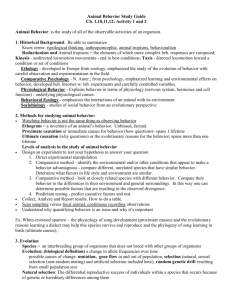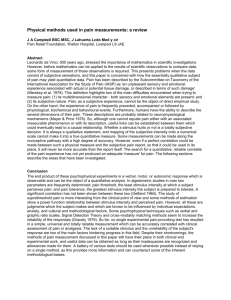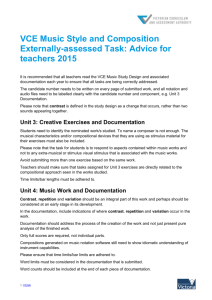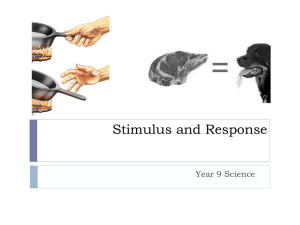Transcripts/01_28 1
advertisement
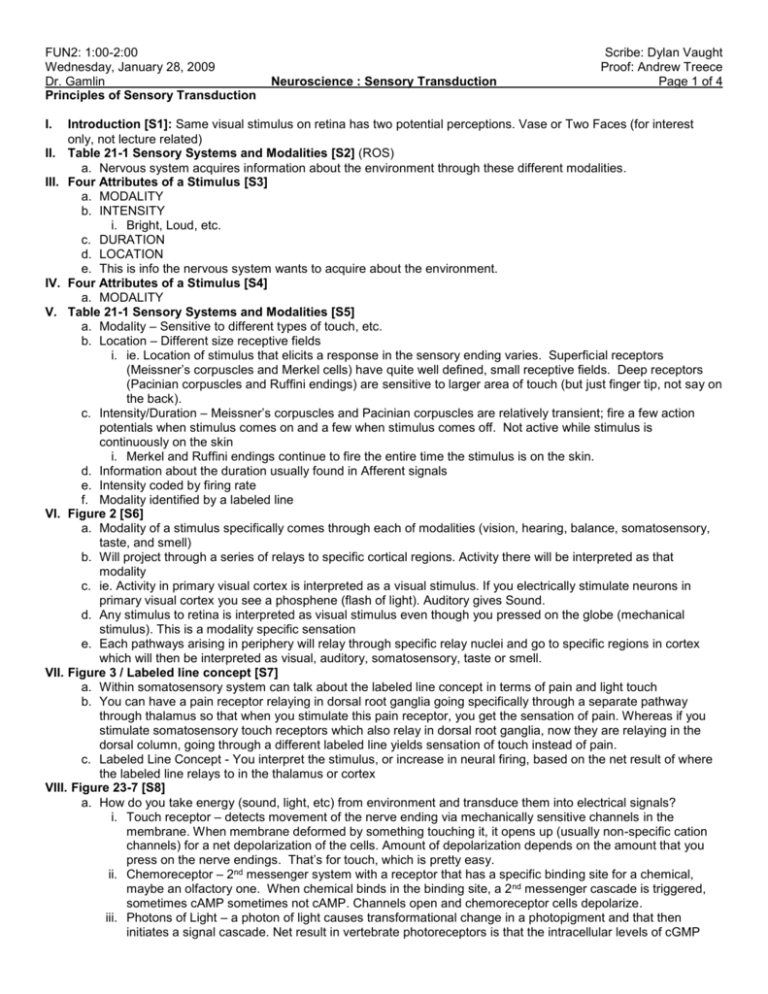
FUN2: 1:00-2:00 Wednesday, January 28, 2009 Dr. Gamlin Principles of Sensory Transduction I. Neuroscience : Sensory Transduction Scribe: Dylan Vaught Proof: Andrew Treece Page 1 of 4 Introduction [S1]: Same visual stimulus on retina has two potential perceptions. Vase or Two Faces (for interest only, not lecture related) II. Table 21-1 Sensory Systems and Modalities [S2] (ROS) a. Nervous system acquires information about the environment through these different modalities. III. Four Attributes of a Stimulus [S3] a. MODALITY b. INTENSITY i. Bright, Loud, etc. c. DURATION d. LOCATION e. This is info the nervous system wants to acquire about the environment. IV. Four Attributes of a Stimulus [S4] a. MODALITY V. Table 21-1 Sensory Systems and Modalities [S5] a. Modality – Sensitive to different types of touch, etc. b. Location – Different size receptive fields i. ie. Location of stimulus that elicits a response in the sensory ending varies. Superficial receptors (Meissner’s corpuscles and Merkel cells) have quite well defined, small receptive fields. Deep receptors (Pacinian corpuscles and Ruffini endings) are sensitive to larger area of touch (but just finger tip, not say on the back). c. Intensity/Duration – Meissner’s corpuscles and Pacinian corpuscles are relatively transient; fire a few action potentials when stimulus comes on and a few when stimulus comes off. Not active while stimulus is continuously on the skin i. Merkel and Ruffini endings continue to fire the entire time the stimulus is on the skin. d. Information about the duration usually found in Afferent signals e. Intensity coded by firing rate f. Modality identified by a labeled line VI. Figure 2 [S6] a. Modality of a stimulus specifically comes through each of modalities (vision, hearing, balance, somatosensory, taste, and smell) b. Will project through a series of relays to specific cortical regions. Activity there will be interpreted as that modality c. ie. Activity in primary visual cortex is interpreted as a visual stimulus. If you electrically stimulate neurons in primary visual cortex you see a phosphene (flash of light). Auditory gives Sound. d. Any stimulus to retina is interpreted as visual stimulus even though you pressed on the globe (mechanical stimulus). This is a modality specific sensation e. Each pathways arising in periphery will relay through specific relay nuclei and go to specific regions in cortex which will then be interpreted as visual, auditory, somatosensory, taste or smell. VII. Figure 3 / Labeled line concept [S7] a. Within somatosensory system can talk about the labeled line concept in terms of pain and light touch b. You can have a pain receptor relaying in dorsal root ganglia going specifically through a separate pathway through thalamus so that when you stimulate this pain receptor, you get the sensation of pain. Whereas if you stimulate somatosensory touch receptors which also relay in dorsal root ganglia, now they are relaying in the dorsal column, going through a different labeled line yields sensation of touch instead of pain. c. Labeled Line Concept - You interpret the stimulus, or increase in neural firing, based on the net result of where the labeled line relays to in the thalamus or cortex VIII. Figure 23-7 [S8] a. How do you take energy (sound, light, etc) from environment and transduce them into electrical signals? i. Touch receptor – detects movement of the nerve ending via mechanically sensitive channels in the membrane. When membrane deformed by something touching it, it opens up (usually non-specific cation channels) for a net depolarization of the cells. Amount of depolarization depends on the amount that you press on the nerve endings. That’s for touch, which is pretty easy. ii. Chemoreceptor – 2nd messenger system with a receptor that has a specific binding site for a chemical, maybe an olfactory one. When chemical binds in the binding site, a 2 nd messenger cascade is triggered, sometimes cAMP sometimes not cAMP. Channels open and chemoreceptor cells depolarize. iii. Photons of Light – a photon of light causes transformational change in a photopigment and that then initiates a signal cascade. Net result in vertebrate photoreceptors is that the intracellular levels of cGMP FUN2: 1:00-2:00 Scribe: Dylan Vaught Wednesday, January 28, 2009 Proof: Andrew Treece Dr. Gamlin Neuroscience : Sensory Transduction Page 2 of 4 decrease and under those conditions, channels close. Vertebrate photoreceptor hyperpolarizes in response to light being absorbed by the photopigment (this is an unusual exception) iv. Main Point - You can directly activate channels or use 2nd cascade to cause an amplification of signal and change the channel opening. (One photon of light can result in many thousands of cGMP molecules decreasing for a large amplification potential) IX. Sensory Transduction by Mechanoreceptors [S9] a. Diagram of muscle stretch receptor, could be any other mechanoreceptor nerve in skin, same basic principle is true. b. There are stretch-sensitive channels in nerve endings. As you deform the membrane more and more, you find that there is an increasing depolarization of this nerve fiber. As you stretch the nerve fiber and just deflect it a few hundred microns, the cell depolarizes more and more. How does this happen? i. Use electrode to record from channels as you distort the membrane slightly ii. As you increase pressure, channels tend to stay open longer and more frequently (more open = more depolarization) iii. If cell depolarizes enough to reach threshold you get an action potential iv. The more you depolarize the cell, the higher the rate of action potential generation v. You go from a graded potential to a firing rate code of an action potential to the spinal cord X. Figure 29 [S10] a. Hair cells have highly specialized mechanoreceptors in the vestibular and auditory systems. Sensitive to displacements based on mechanical amplification (like a lever arm, when lever moves a small amount, it pulls on the channels) b. Can be sensitive enough to go from closed to open with less than 1 micron of stereocilium moving c. Can make stereoreceptors very sensitive by using mechanical amplification XI. [S11] a. Specialized hair cells with stereocilia and one large kinocilium have a resting receptor potential b. Depolarizes somewhat when stereocilia move toward kinocilium, increasing neurotransmitter release, causes nonspecific cation channels to open here, nerve fiber depolarizes, increased firing rate on afferent fiber c. Hyperpolarizes when stereocilia move away from kinocilium, decreasing neurotransmitter release, causes channels to close here, nerve fiber hyperpolarizes, decreased firing rate on afferent fiber d. Similar to naked nerve endings in skin, but uses specialized processes in the hair cells to modulate activity of the afferent fiber XII. Figure 21-3 [S12] a. Reemphasize the 2nd messenger cascade concept i. Chemoreceptor – Odorant molecule binds here, initiates cascade, opening of channels ii. Photoreceptor – Light binds to rhodopsin, conformational change, cascade of signal, decrease of cGMP, some channel closing, cell hyperpolarizes XIII. Figure 1 [S13] (ROS) a. Modulate synaptic output then affect the postsynaptic cell i. Vision – Transducin (G-protein) – Phosphodiesterase (G-protein target) – cGMP (2nd messenger) ii. Olfactory and Sweet/Bitter taste system 2nd messenger is cAMP:IP3 b. Generate impulses directly i. Salt/sour directly activates channels ii. Mechanoreceptors similar to salt/sour XIV. FOUR ATTRIBUTE OF A STIMULUS [S14] a. INTENSITY i. Coding intensity is quite a challenge ii. Hearing from 0-140 dB (log scale, 140 is 10^7 times louder than the softest sound you can hear) iii. Visual range from dim to brightest is about 10 billion iv. Highest firing rate of nerve fiber is ~1,000 action potentials per second 1. Requires a coding scheme of about 0-1000. Quite a challenge to cram all of that range of different levels of intensity into a coding scheme of 0-1000. XV. Figure 23-1 / Psychometric Function [S15] a. If stimulus is really, really weak, not detected. If very loud, heard 100% of the time. b. Relationship between stimulus intensity and response (detection probability) c. Threshold at 50% detection rate XVI. Figure 23-2 [S16] a. Curves can undergo adaptation based on previous exposure to stimuli. Think about light, and how it is easier to see a dim light in a bright room because you are light adapted, but if you are sitting in a dark room and are dark adapted that same stimulus will be easier to see. FUN2: 1:00-2:00 Scribe: Dylan Vaught Wednesday, January 28, 2009 Proof: Andrew Treece Dr. Gamlin Neuroscience : Sensory Transduction Page 3 of 4 XVII. Figure 23-8 [S17] a. Can link probability of detecting stimulus to the underlying firing rate of neurons, and if you stimulate a neuron it won’t fire any action potentials until you reach a threshold. b. Pre-threshold = no firing of action potentials XVIII. PSYCHOPHYSICAL LAWS GOVERN THE PERCEPTION OF STIMULI AND STIMULUS INTENSITY [S18] a. WEBER’S LAW: ∆S = K x S i. Weber’s Law or Just noticeable difference (JND) – Stimulus has to change by a certain proportion to notice it as being noticeable brighter or louder ii. Where ∆S is the minimal difference in strength between a reference stimulus S and a second stimulus that can be discriminated, and K is a constant. ∆S is also termed the just noticeable difference (JND). b. WEBER-FECHNER LAW: I = K log S/S0 i. Where I is the intensity of the sensation experienced by the subject, S0 is the threshold amplitude of the stimulus, and K is a constant. ii. The perceived intensity change would increase as a function of the log of the ratio of the two stimuli iii. Vision works on a log scale to allow nervous system to operate, remember the large range of the visual system. Instead of going from one to a million, you can just go from one to six and scale down the intensity. iv. Not always a logarithm relationship in other sensory areas. Pain sensory system works as a power function (see below). If you double pain, the perception of pain goes up more than a factor of two, it’s actually more than that and exponential or power function. c. STEVEN’S POWER LAW: I = K (S-S0)n n could be any number that is characteristic of a specific stimulus. XIX. Figure 23-9 [S19] a. Coding of intensity depends on the sensory system in question. Represented by power law to scale into the firing rates of neurons. Notice the slopes change from the left to the right figure (log scale) i. Pain has an exponent of 3.5 so it would go off this chart ii. Visual is ~0.4 XX. FOUR ATTRIBUTES OF A STIMULUS [S20] a. DURATION XXI. Figure 23-9 [S21] Two types: a. Rapidly adapting / Transient receptors – fire only when things change (on or off) and it doesn’t bother to tell you that it’s on all the time, like how we wear clothes without thinking about it because our transient receptors have adapted b. Slowly adapting – lightly touch skin, response fades over time. (He thinks this is why dentists rub skin vigorously before inserting needle into someone’s gums) XXII. Figure 21-10 [S22] a. Pacinian corpuscle – steady transient receptors that care about vibration in a specific frequency range. Constantly firing when rubbing fingers over rough surfaces, yet transient over steady pressures. XXIII. FOUR ATTRIBUTES OF A STIMULUS [S23] a. LOCATION XXIV. RECEPTIVE FIELDS FOR TOUCH [S24] a. There is a somatotopic map of the body in somatosensory cortex b. In dorsal root ganglia, each nerve ending goes to a specific part of the skin. c. The receptive field of a sensory neuron is the region over which a stimulus alters neuronal activity. i. Can increase or decrease the firing rate. Concept is change. Very important. XXV. Figure 21-4 / FREQUENCY TUNING [S25] a. Vision, touch have map in cortex, but auditory system is a little different. b. Auditory is not a map of stimulus location, instead it is a tonotopic map of the frequency of sounds. Ears get information about the frequency of sounds. Frequency dependent receptive field, not spatial receptive field. XXVI. Lateral Inhibition/center surround increase contrast [S26] a. Sensory systems want to emphasize contrast between stimuli that are different in different spatial locations. Visual system interested in any contrast (luminance or chromatic) b. Lateral inhibition can come from any connection of cells. c. Each primary cell makes an excitatory connection to a relay cell (the red arrow). d. Each primary cell also makes inhibitory connections to neighboring cells. e. The bottom left cell is not receiving an excitatory connection from the cell above it, but it is being inhibited by the cell above and to the right of it. f. Line thickness is supposed to show the response of the cell so the middle cell is responding more. FUN2: 1:00-2:00 Scribe: Dylan Vaught Wednesday, January 28, 2009 Proof: Andrew Treece Dr. Gamlin Neuroscience : Sensory Transduction Page 4 of 4 g. This is a way of amplifying differences between stimuli between different locations. h. 1 dimension is referred to as lateral inhibition i. 2 dimensions is referred to as center surround, so in this case, the center stimulus inhibits the cells around it, which is the case in the visual and auditory systems. Excitatory frequencies inhibit side bands. XXVII. Figure 4 [S27] a. Somatosensory system b. Visual – emphasizes chromatic contrast, center surround c. Auditory – inhibit side bands, lateral inhibition XXVIII. Figure 7 [S28] a. Visual – the central 10 degrees of vision takes up half the map of visual space, fovea magnified even more b. Somatosensory– tongue, lips, digits. (Remember HAL?) c. end transcript (47:38 minutes)




